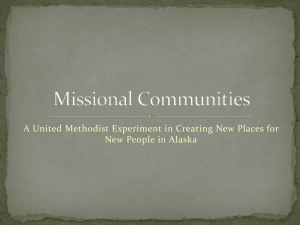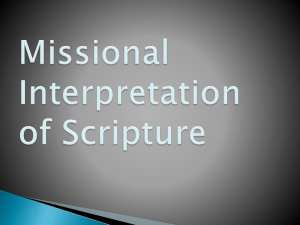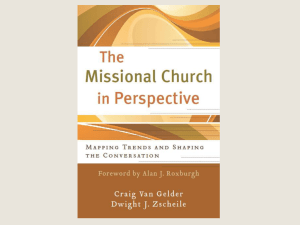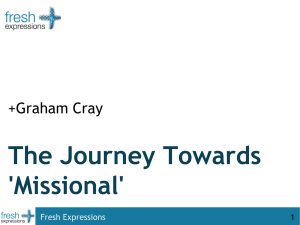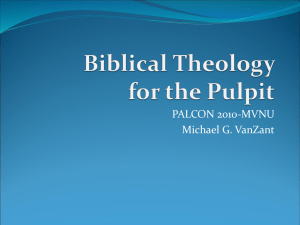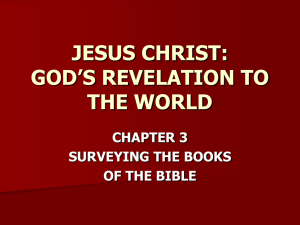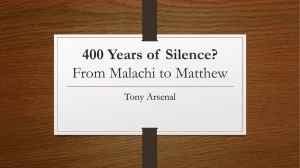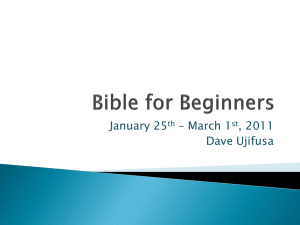Probing a Missional Hermeneutic
advertisement
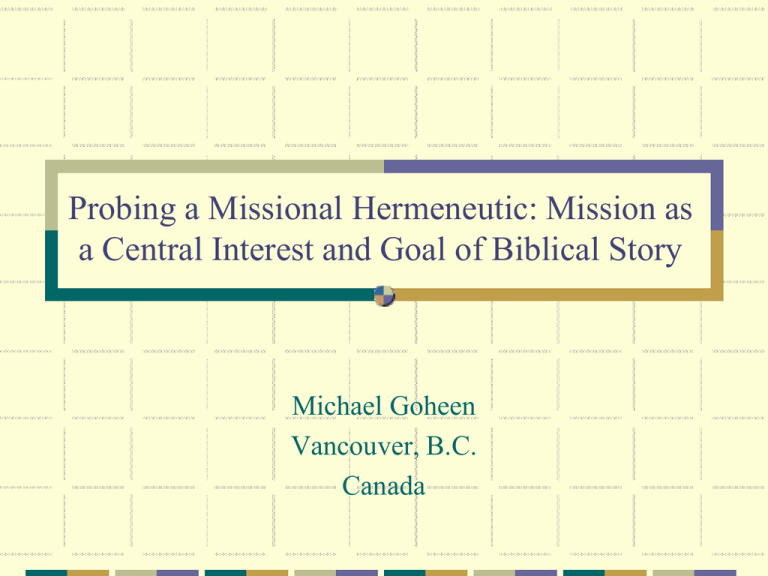
Probing a Missional Hermeneutic: Mission as a Central Interest and Goal of Biblical Story Michael Goheen Vancouver, B.C. Canada A missional hermeneutic is a way of reading Scripture . . . . . . in which mission is the hermeneutical key . . . not simply a study of the theme of mission in the biblical writings, but a way of reading the whole of Scripture with mission as its central interest and goal . . . which seeks to understand what the church’s mission really is in the world as Scripture depicts it . . . which inspires and informs the church’s missionary praxis Mission as key that unlocks biblical story ‘Mission is not just one of a list of things that the Bible happens to talk about, only a bit more urgently than some. Mission is, in that much-abused phrase, what it is all about.’ ‘Mission is a major key that unlocks the whole grand narrative of the canon of Scripture.’ (Chris Wright) Framing the Old Testament The canonical Old Testament frames the entire story of God’s people as the divine answer to the problem of evil: somehow, through this people, God will deal with the problem that has infected his good creation in general and his imagebearing creatures in particular. Israel is to be God’s royal nation of holy priests, chosen out of the world but also for the sake of the world. Israel is to be the light of the world: the nations will see in Israel what it means to be truly human, and hence who the true God is. (N.T. Wright) Two texts as hermeneutical lens Genesis 12.2-3: Blessed to be a blessing (cf. Gen 18.18-19) Backdrop of creation and sin ‘This broad foundation on which Israel's election rests does remind us, however, that her election cannot be the end goal. God's revelation, which becomes focused on Israel, has the nations in its ultimate purview’ (H. Bavinck). “Twofold agenda”—recipient then channel ‘What is being offered in these few verses is a theological blueprint for the redemptive history of the world, now set in train by the call of Abram.’ (William Dumbrell) Two texts as hermeneutical lens Genesis 12.2-3: Blessed to be a blessing Exodus 19.3-6: Display people Redeemed: Liberated from Egyptian empire (1- 18) Bound to God in covenant (19-24) The purpose of the covenant was never simply that the creator wanted to have Israel as a special people, irrespective of the rest of the world. To forget the aim of the covenant is for the sake of the nations is to betray the purpose for which that covenant was made. It is as though the postman were to imagine that all the letters in his bag were intended for him. (NT Wright) Two texts as hermeneutical lens Genesis 12.2-3: Blessed to be a blessing Exodus 19.3-6: Display people Redeemed: Liberated from Egyptian empire (1-18) Bound to God in covenant (19-24) Israel’s vocation: Three titles (19.3-6) Israel is to be ‘a display-people, a showcase to the world of how being in covenant with Yahweh changes a people.’ (John Durham) ‘The history of Israel from this point on is in reality merely a commentary upon the degree of fidelity with which Israel adhered to this Sinai-given vocation.’ (Dumbrell) Torah and presence of God (20-23; 25-40) [cf. Deut 4.58] People of God in Old Testament Genesis 12.2-3: Blessed to be a blessing Exodus 19.3-6: Display people Placed on display in the land to be visible to the nations A display people visible to the nations The ‘visibility of Israel was part of its theological identity and role as the priesthood of yhwh among the nations.’ (Chris Wright) “God’s people living in God’s way in the sight of the nations.” (Wright) “Israel knew that it lived under constant surveillance of the then contemporary world.” Israel was to live out its history “as something enacted before the eyes of the surrounding peoples, ever conscious that the glory of God was at issue.” (JH Bavinck) People of God in the Old Testament Genesis 12.2-3: Blessed to be a blessing Exodus 19.3-6: Display people Placed on display in the land to be visible to the nations Failure and prophets Failure of Israel to live up to their identity to be light to the nations. Promise of prophets: End-time kingdom when 1) Israel would be gathered and renewed, and 2) then nations incorporated Old Testament theology has paid scant attention to the motif of “gathering,” whereas ‘the “gathering of the scattered people of God” has been . . . one of the fundamental statements of Israel’s theology.’ (Gerhard Lohfink) Church in the Biblical Story Genesis 12.2-3: Blessed to be a blessing Exodus 19.3-6: Display people Placed on display in the land to be visible to the nations Failure and prophets Jesus gathers and renews Israel Already-not yet era of kingdom Rabbinic Hope Spirit Messiah Sin Death Evil Satan Knowledge of God Love Joy Justice OLD AGE AGE TO COME New Testament Fulfillment Powers of sin death evil Satan OLD AGE Power of Spirit’s renewing work AGE TO COME Already-not yet as time of mission One may say thus that the interim is preoccupied with the command of mission, and it is the command of mission that gives the interim meaning. . . . mission and the interim are inseparable. (JH Bavinck) Church in the Biblical Story Genesis 12.2-3: Blessed to be a blessing Exodus 19.3-6: Display people Placed on display in the land to be visible to the nations Failure and prophets Jesus gathers and renews Israel Already-not yet era of kingdom Time of gathering (sheep, harvest, people to banquet) Jesus gathers a people ‘After a history of more than a millenium [sic], the people of God could neither be founded nor established, but only gathered and restored.’ (Lohfink) ‘. . . the only significance of the whole of Jesus’ activity is to gather the eschatological people of God.’ (Joachim Jeremias) ‘That God has chosen and sanctified his people in order to make it a contrast-society in the midst of the other nations was for Jesus the self-evident background of all his actions.’ In Jesus we see God’s ‘eschatological action’ to ‘restore or even re-establish his people, in order to carry out definitively and irrevocably his plan of having a holy people in the midst of the nations.’ (Lohfink) Church in the Biblical Story Genesis 12.2-3: Blessed to be a blessing Exodus 19.3-6: Display people Placed on display in the land to be visible to the nations Failure and prophets Jesus gathers and renews Israel Gathers during already-not yet period Forms into display community Jesus forms followers into display community Jesus restores them to be a distinctive people Invitation to centre life in Him Summons to be part of what He is doing Teaching Modelling ‘Thus, there arose in the midst of ancient Israel—unobtrusively at first and yet irreversibly—the new society planned by God.’ (Lohfink) Church in the Biblical Story Genesis 12.2-3: Blessed to be a blessing Exodus 19.3-6: Display people Placed on display in the land to be visible to the nations Failure and prophets Jesus gathers and renews Israel Already-not yet era of kingdom Time of gathering Forms into display community Renews them in death, resurrection, and Spirit Death, Resurrection, and Pentecost Cosmic scope: Turning point in history Death: Decisive defeat of powers of old age Resurrection: Inauguration of renewed creation Spirit brings life of new creation Gathered end-time community participates in life of kingdom/new creation Cosmic-communal-individual Church in the Biblical Story Genesis 12.2-3: Blessed to be a blessing Exodus 19.3-6: Display people Placed on display in the land to be visible to the nations Failure and prophets Jesus gathers and renews Israel Already-not yet era of kingdom Time of gathering Forms into display community Renews them with death, resurrection, and Spirit Gathered renewed Israel sent Commissions community Acts tells story of newly configured mission Acts 1.1-11 Story of Jesus’ continuing mission (1.1) Resurrection, kingdom, Spirit: End time! Now the kingdom will come, right? (1.6) Jesus’ answer: Not yet! Already! Spirit will give foretaste of kingdom Until then you are a community that witnesses to the coming of the kingdom starting here to the ends of the earth To the ends of the earth [change of direction] ‘When the Spirit comes to them and gives them the gift of power, their very identity will be transformed into that of witnesses. . . . Be, say, do good news.’ (Guder) ‘The meaning of this “overlap of the ages” in which we live, the time between the coming of Christ and His coming again, is that it is the time given for the witness of the apostolic Church to the ends of the earth. The end of all things, which has been revealed in Christ, is—so to say—held back until witness has been borne to the whole world concerning the judgment and salvation revealed in Christ. The implication of a true eschatological perspective will be missionary obedience, and the eschatology which does not issue in such obedience is a false eschatology.’ - Lesslie Newbigin Gathering and mission in Acts Already-not yet as time opens up for mission Time of gathering First the Jew (first part of Acts) And then the Gentile (last part of Acts) Model Churches Acts 2.24-27: Church in Jerusalem Devote themselves to Word, Lord’s Supper, fellowship, prayer ACTS 2.42 Model Churches in Acts Acts 2.24-27: Church in Jerusalem Devote themselves to Word, Lord’s Supper, fellowship, prayer Attractive life in midst of community Lord adds to their number Acts 11, 13: Church in Antioch Faithful, like church in Jerusalem Missions to the ends of the earth Spontaneous Expansion of Church in Acts Attractive life of the community Spontaneous evangelism by common members of the church Planting new churches - Roland Allen Ministry of Paul Pioneer church planting (Rom 15.20, 23) Nurture communities to faithful display people Through return visits Through letter Mission and missions (Newbigin); Organic and sending mode (Shenk) Jerusalem Council: A Church Among the Cultures of the World Growth of new communities raise critical questions about God’s people and culture ‘. . . not even the original, divinely sanctioned culture of God’s elect nation has the right to universalize its particular expression of Christianity.’ (Flemming) Missionary encounter with culture: Redemptive tension as church lives as distinctive people Continuity and Discontinuity with Old Testament Like Israel: Missionary encounter with idolatrous cultures which embrace insight and rejects idolatry Unlike Israel: Sent to live in the midst of the cultures of the world and so becomes a people with many cultural expressions Ending of Acts: 28 Why so abrupt? Loose ends? Story of Acts has not ended Continues today until Christ returns . . . the ending of Acts is truly an opening to the continuing life of the messianic people, as it continues to preach the kingdom and teach the things concerning Jesus both boldly and without hindrance (Johnson). Mission of the church today Being a light to the nations: Continuing the mission of Israel (Ex 19.3-6 cf. 1 Pet 2.9) Making known the kingdom: Continuing the mission of Jesus (John 20.21) Bearing faithful witness: Continuing the mission of the early church Probing a Missional Hermeneutic: The Nature of Mission and Implications for Pastoring and Church-Planting Lecture Two: Calvin Seminary MISS 664 Michael Goheen Vancouver, B.C. Canada A missional hermeneutic is a way of reading Scripture . . . . . . in which mission is the hermeneutical key . . . not simply a study of the theme of mission in the biblical writings, but a way of reading the whole of Scripture with mission as its central interest and goal . . . which seeks to understand what the church’s mission really is in the world as Scripture depicts it . . . which inspires and informs the church’s missionary praxis Nature of mission Oriented to world Participation in God’s mission involves two orientations Chosen by God for the sake of the world “. . . oriented toward two fronts: toward God and toward the world.” (M. Barth) “It is a matter of the church’s very being to turn towards the world . . .” (GC Berkouwer) Nature of mission Oriented to world Demonstrating what it means to be truly human: Facing three directions New being: A witness as wide as life “. . . model genuinely human existence” and “demonstrate what it means to be truly human” (NT Wright) Facing in three directions Nature of mission Oriented to world Demonstrating what it means to be truly human: Facing three directions Missionary dimension and missionary intention Missionary dimension and intention Missional dimension: “Because the Church is the mission there is a missionary dimension of everything that the Church does. But not everything the Church does has a missionary intention.” Missional intention: “. . . an action of the Church in going out beyond the frontiers of its own life to bear witness to Christ as Lord among those who do not know Him, and when the overall intention of that action is that they should be brought from unbelief to faith.” Nature of mission Oriented to world Demonstrating what it means to be truly human: Facing three directions Missionary dimension and missionary intention Preview and instrument Preview and Instrument Preview: Embodies new creation in its own life Instrument: Agent of renewal in life of society and culture The church is designed—it isn’t too strong a word—to be a sign and foretaste of what God wants to do for the entire cosmos. What’s more, such people are not just to be a sign and foretaste of that ultimate salvation; they are to be part of the means by which God makes this happen in both the present and the future. (N.T. Wright) We move from worship straight into tasks like humanizing and harmonizing beauty in architecture, work in office and shop, shaping public life, campaigning for decent libraries and sporting facilities, discussing town planning, running playgroups for children of single working moms, organising credit unions for the poor, and creative and healthy farming methods, among other things, and then repeats the refrain three times: ‘This is not an extra to the church’s mission. It is central.’ (NT Wright) Nature of mission Oriented to world Demonstrating what it means to be truly human: Facing three directions Missionary dimension and missionary intention Preview and instrument Missions to the ends of the earth Missions Establishing a witness where there is none Horizon of mission: Ends of the earth Missions eclipsed Every congregation shares in this missionary task ... every church, however small and weak, ought to have some share in the task of taking the gospel to the ends of the earth. Every church ought to be engaged in foreign missions. This is part of the integrity of the gospel. We do not adequately confess Christ as the Lord of all men if we seek to be his witnesses only among our neighbours. We must seek at the same time to confess him to the ends of the earth. The foreign missionary enterprise belongs to the integrity of our confession. (Newbigin) Nature of mission Oriented to world Demonstrating what it means to be truly human: Facing three directions Missionary dimension and missionary intention Preview and instrument Missions to the ends of the earth Rooted in the gathered worship life of the church ‘All will need to be nourished by the central, worshipping life of the church, and the central life will itself be nourished and renewed as the friends of Jesus come back to worship from their mission in the world. . . . to be truly effective in this kind of mission, one must be genuinely and cheerfully rooted . . . within the life of the church. There is no use . . . trying to get fruit from a tree whose roots you have systematically dug up.’ (NT Wright) A missional hermeneutic is a way of reading Scripture . . . . . . in which mission is the hermeneutical key . . . not simply a study of the theme of mission in the biblical writings, but a way of reading the whole of Scripture with mission as its central interest and goal . . . which seeks to understand what the church’s mission really is in the world as Scripture depicts it . . . which inspires and informs the church’s missionary praxis Implications for pastors and church planters Worship that nurtures our missional identity 2. Preaching the gospel of the kingdom 3. Devoted to communal prayer 4. Nurturing a contrast community 1. Countercultural community ‘. . . mission is not primarily about going. Nor is mission primarily about doing anything. Mission is about being. It is about being a distinctive kind of people, a countercultural . . . community among the nations.’ (Howard Peskett and Vinoth Ramachandra) ‘They would have to sing better songs for me to learn to have faith in their Redeemer: and his disciples would have to look more redeemed!’ - Friedrich Nietzsche A contrast community looking more redeemed today A community of justice in a world of economic and ecological injustice A community of generosity and simplicity (of ‘enough’) in a consumer world A community of selfless giving in a world of selfishness A community of truth (humility and boldness) in a world of relativism and uncertainty A community of hope in a world of disillusionment and consumer satiation A community of joy and thanksgiving in a hedonistic world that frantically pursues pleasure A community who experiences God’s presence in a secular world Implications for pastors and churchplanters 5. Understanding cultural context 6. Training members for missionary encounter in their callings in culture Callings in public square Newbigin speaks of the “deep-seated and persistent failure of the churches to recognize that the primary witness to the sovereignty of Christ must be given, and can only be given, in the ordinary secular work of lay men and women in business, in politics, in professional work, as farmer, factory workers and so on.” His conviction is that “enormous preponderance of the Church’s witness is the witness of the thousands of its members who work in field, home, office, mill or law court.” (Newbigin) Implications for pastors and churchplanters 7. Training members to do evangelism in an organic way 8. Involvement in the needs of neighbourhood and the world 9. Commitment to missions Implications for pastors and churchplanters Training leaders 11. Training parents to take up the task of nurturing children in the faith 12. Small groups 13. Expressing and seeking the unity of the body of Christ 10. Probing a Missional Hermeneutic: The Church’s Missional Praxis Public Lecture CalvinTheological Seminary Michael Goheen Vancouver, B.C. A missional hermeneutic is a way of reading Scripture . . . . . . in which mission is the hermeneutical key . . . not simply a study of the theme of mission in the biblical writings, but a way of reading the whole of Scripture with mission as its central interest and goal . . . which seeks to understand what the church’s mission really is in the world as Scripture depicts it . . . which inspires and informs the church’s missionary praxis Biblical authority and mission of church Biblical authority is a “sub-branch . . . of the mission of the church.” Biblical authority defined by its place and role in the biblical story God’s “self-revelation is always to be understood within the category of God’s mission to the world, God’s saving sovereignty let loose through Jesus and the Spirit and aimed at the healing and renewal of the creation.” (NT Wright) To understand biblical authority we must grasp how it works to shape a missional people and through them the healing of the world Scripture forming churches for mission The writings that became the canonic New Testament all functioned basically as instruments for the continuing formation of these communities for the faithful fulfillment of their missional vocation. . . . a missional hermeneutic . . . constantly asks, “How did this written testimony form and equip God's people for their missional vocation then, and how does it do so today?” (Darrell Guder) Record and tool “The apostolic writings . . . were not simply about the coming of God’s Kingdom into all the world; they were, and were designed to be, part of the means by which that happened.” (NT Wright) Record of God’s mission and tool to effectively bring it about Old Testament and formation of missional people Old Testament as tool of God’s missional purposes “. . . a full account of the role of scripture within the life of Israel would appear as a function of Israel’s election by God for the sake of the world. Through scripture, God was equipping his people to serve his purposes.” Equipping is “inadequate shorthand for the multiple tasks scripture accomplished.” Equipping and forming a people to be a light to the nations Torah ordered national, liturgical, and moral life Wisdom shaped daily conduct in conformity with God’s creation order Prophets were covenant enforcers that called Israel back to missional vocation with threats and promises Psalms nourish faithfulness and universal horizon in worship (Boda: “psalms as missional collection”) Historical books retold Israel’s story reminding them of their place in the story A distinctive people that encounter pagan cultures Story of Exodus confronts rival religious claims of Pharaoh and Egypt Story of creation is polemic against creation myths of Ancient Near East Historical narratives and pre-exilic prophets depict Israel’s struggle with religious cultures of Canaan Exilic and post-exilic books emerge to define Israel’s identity amidst large pagan empires Wisdom texts engage pagan wisdom traditions “with a staunch monotheistic disinfectant” Psalms and prophets nourish calling of Israel to be a distinctive people in midst of nations Central question “How did this written testimony form and equip God's people for their missional vocation then, and how does it do so today?” Scipture and formation of missional people Old Testament as tool of God’s missional purposes New Testament as tool of God’s missional purposes Jesus fulfils the purpose of the Old Testament Jesus fulfils purpose of Old Testament Purpose: Form and equip people for missional calling [salvation in them for nations] “For what the law was powerless to do because it was weakened by the sinful nature, God did by sending his own Son . . .” (Rom 8.3-4) “Jesus thus does, climactically and decisively, what scripture had in a sense been trying to do: bring God’s fresh Kingdom order to God’s people and thence to the world.” Heightens importance of centrality of Christ in preaching, also missional implications Scripture and formation of missional people Old Testament as tool of God’s missional purposes New Testament as tool of God’s missional purposes Jesus fulfils the purpose of the Old Testament Apostolic proclamation of Jesus: Transforming power of God Apostolic verbal proclamation “It was the story of Jesus (particularly his death and resurrection), told as the climax of the story of God and Israel and thus offering itself as both the true story of the world and the foundation and energizing force for the church’s mission.” Proclaiming Christ: Making him present to accomplish purpose of forming and equipping people Powerful word: calls into existence a missional community, shapes them to be faithful people, works through them to draw others to faith Marturia, kerygma, didache (Ridderbos) Scripture and formation of missional people Old Testament as tool of God’s missional purposes New Testament as tool of God’s missional purposes Jesus fulfils the purpose of the Old Testament Apostolic proclamation of Jesus: Transforming power of God New Testament canon: Literary expression of apostolic proclamation New Testament canon and formation of missional people Proclamation, witness, teaching of apostles takes literary form in NT NT “carried the same power, the same authority in action, that had characterized the initial preaching of the word.” Same power, same purpose: to sustain, energise, shape, judge, and renew church for mission in world Epistles of Paul Mission as hermeneutical prerequisite “. . . if the questions to which ancient authors sought to respond in terms available to them within their cultural horizons are to be ‘heard’ today with something like their original force and urgency, they have first to be ‘heard as questions that challenge us with comparable seriousness.” (N. Lash) Implications for preaching Preaching gospel: Christocentric Missional logic Luke 24.45-47: Messianic and Missional Hermeneutic He [Jesus] seems to be saying that the whole of the Scriptures (which we now know as the Old Testament), finds its focus and fulfilment both in the life and death and resurrection of Israel’s Messiah and in the mission to all nations, which flows out from that event. Luke tells us that with these words Jesus ‘opened their minds so they could understand the Scriptures’, or, as we might put it, he was setting their hermeneutical orientation and agenda. The proper way for disciples of the crucified and risen Jesus to read their Scriptures is from a perspective that is both messianic and missional. (C. Wright) Messianic and missional ‘. . . down through the centuries it would probably be fair to say that Christians have been good at their messianic reading of the Old Testament but inadequate (and sometimes utterly blind) at their missional reading of it.’ - Chris Wright Questions regarding preaching Have we reduced salvation to individual savedness? Have we reduced the church’s mission to the maintenance of individual’s salvation? Have we stressed salvation in and for church to the neglect of through the church? Have we separated an individual salvation from the cosmic scope of the kingdom? Have we treated passages apart from books, and books apart from whole story? Implications of missional hermeneutic for preaching Preaching gospel Christocentric Missional logic Salvation: in and for us as well as through us [e.g., Ps 63] Metanarratival Cosmic-communal-individual Missionary encounter themes [Col] Mission and theological education: Some questions Two sources: Missionary tradition (Conn, Newbigin, Bosch) Young pastors and theological students Mutually enriching and correcting dialogue Background: my theological education Important distinction: Missionary dimension and intention In the dimensional aspect of mission, missiology should provoke theology as a whole to discover anew that mission is not simply a more or less neglected department of the church’s life . . . Missiology is not simply yet another subject but a dimension of theology as a whole, an indispensable dimension which must preserve the church from parochialism and provincialism. It constitutes a “test of faith” . . . for church and theology. This implies that missiology has in the first place a critical function and operates as a leaven in theology — sometimes as a gadfly. (Bosch) Concerns about theological education Character, competency, disconnected from local congregation, pedagogy, curriculum Curriculum that forms leaders that lead the church in mission: Content and division “A major problem is that the present division of theological subjects was canonized in a period when the church in Europe was completely introverted.” (Bosch) Theological education in history The period in which our thinking about the Church [including theological education] received its main features was the period in which Christianity had practically ceased to be a missionary religion. . . . It was in this period, when the dimensions of the ends of the earth had ceased to exist as a practical reality in the minds of Christians, that the main patterns of churchmanship were formed. (Newbigin) Missional curricular logic Missional ecclesiology (derived from missio Dei) “. . . the church’s mission is not secondary to its being; the church exists in being sent and in building up itself for the sake of its being.” Missional hermeneutic: “How does this part of Scripture form the people of God for its mission in the world?” Theological education should follow Scripture’s lead “The formation of the church for mission should be the motivating force that shapes and energizes our theological labors in all their diversity and distinctiveness.” (Guder) Biblical studies Has biblical studies served the preaching ministry of the church? (Christocentric, missional, people for sake of world, metanarratival, cosmiccommunal-individual, encounter) The academic guild of biblical scholars has a largely self-generated agenda [that] increasingly excludes the church from its context and implied audience. Biblical scholarship must address the church in its mission to the world and make the church in the West, that is now waking up to its mission, not simply its audience but its dialogue partner. (Richard Bauckham) Biblical studies Have various levels of criticism been made subservient to the missional purpose of Scripture? ‘“How did this written testimony form and equip God’s people for their missional vocation then, and how does it do so today?” All the resources of historical, critical, and literary research on the biblical testimony can and must contribute to the church’s formation by illumining all the dimensions of this fundamental question.’ (Guder explicating Bosch) Theology First theological work done in gospels and epistles—model for theology today? ‘The oldest mission became the mother of theology.’ (Martin Kahler) Theology is ‘an accompanying manifestation of Christian mission’ in New Testament.’ (Bosch) Character of that theological work Equipping church for mission in that place Bringing gospel to bear on particular context Encountering threatening idolatrous, cultural powers (need for more cultural studies?) Theology Have we been sufficiently aware of contextual nature of theology especially confessions in our study of historical theology? “Our creedal formulations, structured to respond to a sixteenth-century cultural setting and its problems, lose their historical character as contextual confessions of faith and become cultural universals, having comprehensive validity in all times and settings.” (Conn) Has our theology sufficiently engaged various cultural theologies that can critique our own cultural blindspots? Questions about church history ‘We have to ask in all sincerity whether the study of the history of the church ought not to be completely redesigned.’ (Bosch) Have we been too focussed on doctrinal controversies and polity issues separated from contextualisation? Church history Has our teaching of church history sufficiently taken into account . . . the missionary nature of church? an encounter with culture in its missional engagement? ‘Church history was not taught in terms of the missionary advance in successive encounters of the gospel with different forms of human culture and society, but rather as a story of the doctrinal and other conflicts within the life of the church.’ (Newbigin) ‘Practical’ theology What does term ‘practical’ say about our curricular division? Are these subjects simply a matter of tactics and skills, methods and practices, how-to techniques, and not rigorous theology? Have the subjects in these areas (homiletics, liturgics, polity, counselling, pastoral care, etc.) been taught from standpoint of maintenance (i.e., pastoral separated from missional, salvation in/for but not through)? Place of mission? Is missiology simply about world evangelisation and the strategy and technique to do it? Is missiology a ‘dispensable addendum’ isolated from the ‘real’ theological work of the seminary? ‘. . . missions maintains its toolshed appearance behind the “stately mansions” of theology.’ (Conn)
